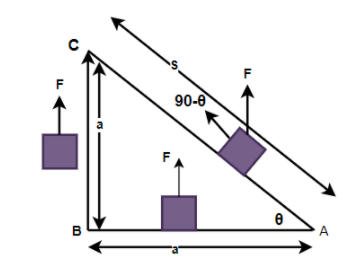
If we shift a body in equilibrium from A to C in a gravitational field via path AC or ABC

(A) The work done by the force \[\vec F\]for both paths will be same
(B) ${W_{AC}} > {W_{ABC}}$
(C) ${W_{AC}} < {W_{ABC}}$
(D) None of the above.
Answer
217.8k+ views
Hint: Displacement depends only on initial and final position. So, the force can be considered as conservative. Work done is given by$W = Fs\cos \theta $. Using this expression find out the work done in both paths and compare them.
Complete step-by-step answer:
Work done by an object is defined as a scalar product of the force and the displacement of the body.
$W = \vec F.\vec s$
$W = Fs\cos \theta $
Here, \[F\]is the force applied on the body and\[\;s\] is the distance through which the body has displaced.
Consider the work done by the body in the path AC,
${W_{AC}} = Fs\cos (90 - \theta )$
${W_{AC}} = mg\sin \theta \left( {\because F = mg} \right)$
${W_{AC}} = mgh \to (1)$
For path AB
${W_{AB}} = Fs\cos 90$
${W_{AC}} = 0$
For path BC
${W_{BC}} = Fs\cos 0$
${W_{BC}} = mgh$
So work done along the path ABC is
${W_{ABC}} = {W_{AB}} + {W_{BC}}$
${W_{ABC}} = mgh \to (2)$
From equation (1) and (2) we know that the work done by the force is the same in both paths.
Hence, the correct option is A.
Note: One can simply see that the starting and the end points in both the paths are the same. Since gravity is a conservative force, we can say that there is no difference in the works.
Work is said to be 1 joule, when 1 newton of force displaces the body through 1 meter in its own direction. The SI unit of work is joules, CSG unit is erg .
Relation between joule and erg.
$1joule = {10^7}erg$
Its dimensional formula is $\left[ {M{L^2}{T^{ - 2}}} \right]$
Complete step-by-step answer:
Work done by an object is defined as a scalar product of the force and the displacement of the body.
$W = \vec F.\vec s$
$W = Fs\cos \theta $
Here, \[F\]is the force applied on the body and\[\;s\] is the distance through which the body has displaced.
Consider the work done by the body in the path AC,
${W_{AC}} = Fs\cos (90 - \theta )$
${W_{AC}} = mg\sin \theta \left( {\because F = mg} \right)$
${W_{AC}} = mgh \to (1)$
For path AB
${W_{AB}} = Fs\cos 90$
${W_{AC}} = 0$
For path BC
${W_{BC}} = Fs\cos 0$
${W_{BC}} = mgh$
So work done along the path ABC is
${W_{ABC}} = {W_{AB}} + {W_{BC}}$
${W_{ABC}} = mgh \to (2)$
From equation (1) and (2) we know that the work done by the force is the same in both paths.
Hence, the correct option is A.
Note: One can simply see that the starting and the end points in both the paths are the same. Since gravity is a conservative force, we can say that there is no difference in the works.
Work is said to be 1 joule, when 1 newton of force displaces the body through 1 meter in its own direction. The SI unit of work is joules, CSG unit is erg .
Relation between joule and erg.
$1joule = {10^7}erg$
Its dimensional formula is $\left[ {M{L^2}{T^{ - 2}}} \right]$
Recently Updated Pages
Elastic Collision in Two Dimensions Explained Simply

Elastic Collisions in One Dimension Explained

Electric Field Due to a Uniformly Charged Ring Explained

Electric Field of Infinite Line Charge and Cylinders Explained

Electric Flux and Area Vector Explained Simply

Electric Field of a Charged Spherical Shell Explained

Trending doubts
JEE Main 2026: Application Form Open, Exam Dates, Syllabus, Eligibility & Question Papers

Derivation of Equation of Trajectory Explained for Students

Hybridisation in Chemistry – Concept, Types & Applications

Understanding the Angle of Deviation in a Prism

Understanding Collisions: Types and Examples for Students

How to Convert a Galvanometer into an Ammeter or Voltmeter

Other Pages
JEE Advanced Marks vs Ranks 2025: Understanding Category-wise Qualifying Marks and Previous Year Cut-offs

Units And Measurements Class 11 Physics Chapter 1 CBSE Notes - 2025-26

NCERT Solutions For Class 11 Physics Chapter 8 Mechanical Properties Of Solids

Motion in a Straight Line Class 11 Physics Chapter 2 CBSE Notes - 2025-26

NCERT Solutions for Class 11 Physics Chapter 7 Gravitation 2025-26

Understanding Atomic Structure for Beginners




